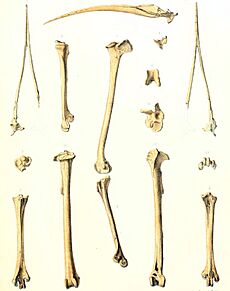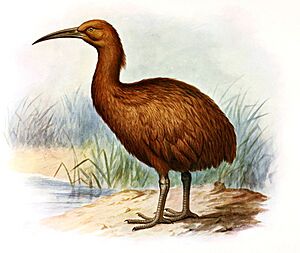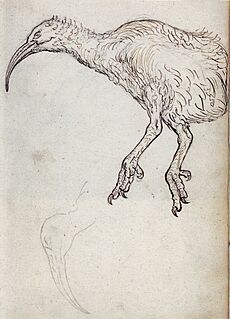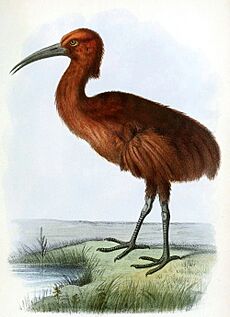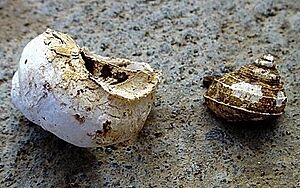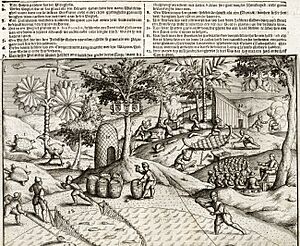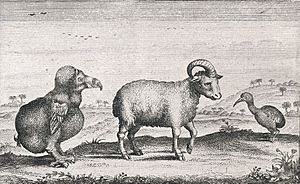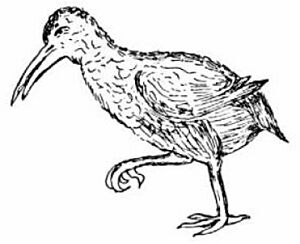Red rail facts for kids
Quick facts for kids Red rail |
|
|---|---|
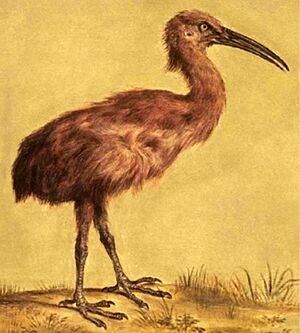 |
|
| Painting of a possibly stuffed specimen by Jacob Hoefnagel, ca. 1610 | |
| Conservation status | |
| Scientific classification | |
| Genus: |
Aphanapteryx
|
| Species: |
bonasia
|
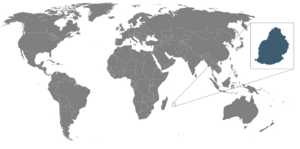 |
|
| Location of Mauritius (in blue) | |
| Synonyms | |
|
List
Apterornis bonasia Selys, 1848
Didus broecki Schlegel, 1854 Didus herbertii Schlegel, 1854 Aphanapteryx imperialis Frauenfeld, 1868 Aphanapteryx imperatoris Frauenfeld, 1868 Aphanapteryx broeckei (Milne-Edwards, 1868) Didus herberti Milne-Edwards, 1868 Didus broeckii Milne-Edwards, 1868 Aphanapteryx broeckii Milne-Edwards, 1869 Pezophaps broeckei (Schlegel, 1873) Pezophaps herbertii (Schlegel, 1873) Aphanapteryx broecki Günther & Newton, 1879 Aphanapteryx broekei Newton & Gadow, 1893 Kuina mundyi Hachisuka, 1937 Pezocrex herberti (Hachisuka, 1953) |
|
The red rail (Aphanapteryx bonasia) was a type of rail bird that is now extinct. It lived only on the island of Mauritius. This island is in the Indian Ocean, east of Madagascar. The red rail had a close relative, the Rodrigues rail, which also became extinct. Rails often lose their ability to fly when they live on isolated islands. This happens because there are no large predators like mammals. The red rail was a bit bigger than a chicken.
It had reddish, hair-like feathers. Its legs were dark and its beak was long and curved. The wings were very small. Its legs were thin for a bird of its size. People thought it looked like a kiwi bird. Scientists believe it ate small creatures like invertebrates. Snail shells have been found with marks that match its beak. People used to hunt red rails by luring them with red cloth. The birds would come close, and then hunters would hit them with sticks.
For a long time, scientists only knew about the red rail from old drawings and writings from the 1600s. In the 1860s, subfossil bones were found. These bones helped scientists understand what the bird really looked like. The last time someone reported seeing a red rail was in 1693. It is thought to have died out around 1700. This was mainly because of hunting by humans and new animals brought to the island.
Contents
Discovering the Red Rail
The red rail was first mentioned in 1598 by a Dutch ship pilot. He called them "Indian river woodcocks." By the 1800s, people only knew about the bird from a few old writings. These writings called them "red hens." There were also sketches by a Dutch merchant and an English traveler.
In 1848, a Belgian scientist named Edmond de Sélys Longchamps gave the bird its scientific name, Apterornis bonasia. He based this name on the old stories. He thought it was related to the dodo because both birds had small wings and tails. The name Apterornis means "invisible-wing."
In 1865, scientists found fossil foot bones and a jaw bone in a swamp on Mauritius. These bones were sent to a French zoologist, Alphonse Milne-Edwards. In 1868, he figured out that they belonged to a rail bird. He connected these bones to the bird in an old painting and the old stories.
Later, more fossils were found in 1889 and 1893. In 1899, a nearly complete skeleton was found in a cave. This is the most complete red rail skeleton we have today. It is kept at the Mauritius Institute.
How the Red Rail Evolved
The red rail was a close relative of the Rodrigues rail. However, scientists are not sure how they are related to other rail birds. These two birds are usually seen as different types, but sometimes they are grouped together. They were first linked because their skeletons were similar.
Rails have traveled to many islands. This often leads to new species and birds that cannot fly. The red rail lost many of its feather features. This suggests it was isolated on the island for a very long time. These rails might have come from Asia, like many other birds on the Mascarene Islands.
Scientists think the ancestors of the red rail arrived on the Mascarene Islands millions of years ago. Birds can lose the ability to fly very quickly, sometimes in just a few generations. This happens in places without predators. But this also makes them very vulnerable to humans and new animals.
What the Red Rail Looked Like
From its bones, drawings, and old descriptions, we know the red rail could not fly. It was a bit larger than a chicken. Its length was about 35 to 40 centimeters (14 to 16 inches). Males might have weighed about 1.3 kilograms (2.9 pounds), and females about 1 kilogram (2.2 pounds).
Its feathers were reddish-brown and looked fluffy and hair-like. Its tail was not easy to see. The short wings also almost disappeared in its feathers. It had a long, slightly curved, brown beak. Some drawings show it had a crest of feathers on its neck. It might have looked like a lightly built kiwi bird.
The red rail's skull was the largest among rails on the Mascarene Islands. The upper part of its beak was long and narrow. Its nostrils were also long. The lower jaw was long too. The differences in beak length might mean that male and female red rails had different sized beaks.
Its shoulder blade was wide. The breast bone and upper arm bone were small. This shows it had lost the power of flight. Its legs were long and thin for a bird of its size. But its pelvis (hip bone) was very wide and strong. The thigh bone was also very strong.
The red rail was different from the Rodrigues rail. It had shorter upper arm bones and a narrower, longer skull. Their leg sizes were similar. The two birds also had very different feathers. The red rail was larger and had slightly smaller wings.
Old Descriptions of the Red Rail
In 1638, an English traveler named Peter Mundy described the red rail:
A Mauritius henne, a Fowle as bigge as our English hennes, of a yellowish Wheaten Colour, of which we only got one. It hath a long, Crooked sharpe pointed bill. Feathered all over, butte on their wings they are soe Few and smalle that they cannot with them raise themselves From the ground. There is a pretty way of taking them with a red cap, but this of ours was taken with a stick. They bee very good Meat, and are also Cloven footed, soe that they can Neyther Fly nor Swymme.
Another English traveler, John Marshall, described the bird in 1668:
Here are also great plenty of Dodos or red hens which are larger a little than our English henns, have long beakes and no, or very little Tayles. Their fethers are like down, and their wings so little that it is not able to support their bodies; but they have long leggs and will runn very fast, and that a man shall not catch them, they will turn so about in the trees. They are good meate when roasted, tasting something like a pig, and their skin like pig skin when roosted, being hard.
Old Pictures of the Red Rail

The most realistic old pictures of red rails are a painting from around 1610 and sketches from a ship's journal from 1601. The painting by Jacob Hoefnagel shows the bird with reddish-brown feathers. This painting is important because it is the only clear colored picture of the species. The bird in the painting was likely brought alive to Europe.
The sketches from the Gelderland ship's journal are the earliest records of the red rail. They were drawn on Mauritius and are considered very accurate. Other older, simpler drawings caused confusion. Some people thought they showed different species.
There are also some paintings by Dutch artist Roelant Savery that might show red rails. One famous painting from 1626 shows a rail-like bird. However, some experts think these birds might be Eurasian bitterns instead.
Life and Habits
Old stories about the red rail don't tell us much about its daily life. But based on where fossils were found, the bird lived all over Mauritius. It lived in mountains, lowlands, and near the coast. The shape of its beak suggests it ate reptiles and invertebrates. Different beak lengths might mean males and females ate different sized foods.
It might have also eaten eggs from bird colonies and tortoise nests. A report from the 1660s said the bird "scratches in the earth with its sharp claws like a fowl to find food such as worms under the fallen leaves."
Scientists think the red rail used its strong, sharp beak to crush molluscs and other shells. Many types of snails lived on Mauritius. Fossil snail shells have been found with holes that match the red rail's beak. The red rail's beak also had many small holes at the front. These holes are like those found in birds that probe for food, such as kiwis. This means the red rail's beak was strong and sensitive. It was a good tool for finding small creatures hidden in the ground.
The red rail was fast and could run away when chased. But it was easy to trick with a red cloth. The birds would come close to attack the cloth. Then, hunters could easily catch them. If a bird was caught and cried out, more red rails would come running. This happened because the birds had grown up without predators. They were curious and not afraid of humans.
Many other animals on Mauritius became extinct after humans arrived. Humans greatly damaged the island's ecosystem. Before humans, Mauritius was covered in forests. Now, very little forest remains. The animals that still live there are in danger. The red rail lived alongside other extinct Mauritian birds like the dodo and the broad-billed parrot.
Red Rails and Humans
Sailors who visited Mauritius from 1598 onwards were mostly interested in the animals for food. The dodo was sometimes not very tasty. But the red rail was a popular bird for Dutch and French settlers to hunt. People wrote that it was easy to catch. They also said that when roasted, it tasted like pork.
A German pastor described a hunt in the 1670s:
... [there is also] a particular sort of bird known as toddaerschen which is the size of an ordinary hen. [To catch them] you take a small stick in the right hand and wrap the left hand in a red rag, showing this to the birds, which are generally in big flocks; these stupid animals precipitate themselves almost without hesitation on the rag. I cannot truly say whether it is through hate or love of this colour. Once they are close enough, you can hit them with the stick, and then have only to pick them up. Once you have taken one and are holding it in your hand, all the others come running up as it [sic] to its aid and can be offered the same fate.
In the late 1600s, people started using the name "dodo" for the red rail. This happened after the dodo itself became extinct. So, some later stories about "dodos" might actually be about red rails. For example, a story from 1681 about a "dodo" said its meat was "hard." This description matches what people said about red rail meat.
Some scientists think that all mentions of "dodos" after 1662 actually refer to the red rail. They believe the dodo disappeared earlier because of feral pigs. New settlers on Mauritius might not have seen real dodos. But they expected to see flightless birds. So, they called the red rail by the dodo's name. Red rails probably had more babies and their eggs hatched faster than dodos. This might have made them less vulnerable to pigs.
Why the Red Rail Disappeared
Many rails that live on islands cannot fly. This makes them very vulnerable to changes caused by humans. Because of this, rails have suffered more extinctions than any other bird family. All six types of rails that lived only on the Mascarene Islands are now extinct. Humans caused all these extinctions.
Besides hunting by humans, the red rail nested on the ground. This made it vulnerable to pigs and other introduced animals. These animals ate their eggs and young. This likely helped cause their extinction. However, red rails had lived with introduced rats since at least the 1300s. The rats did not seem to harm them. Red rails might have been able to defend their nests. They also seemed to survive alongside humans, pigs, and monkeys for a while.
The last person to mention the red rail was a French traveler in 1693. He said the red rail had become rare. So, it is believed the bird became extinct around 1700. Feral cats were brought to Mauritius in the late 1680s to control rats. Cats are very good at hunting ground-dwelling birds. Being curious and fearless, the red rail would have been easy prey for cats. This likely led to its extinction.
Images for kids
-
Labeled sketch from 1634 by Sir Thomas Herbert, showing a broad-billed parrot, a red rail, and a dodo
-
Jacopo Bassano's 1570 painting Arca di Noè, perhaps showing a red rail (or a bittern) in the lower right



